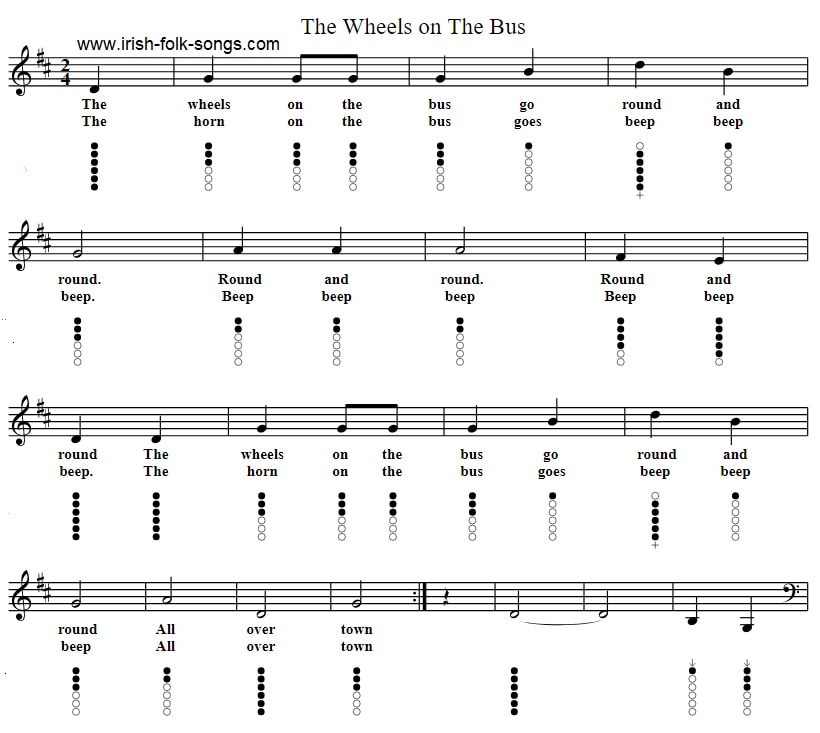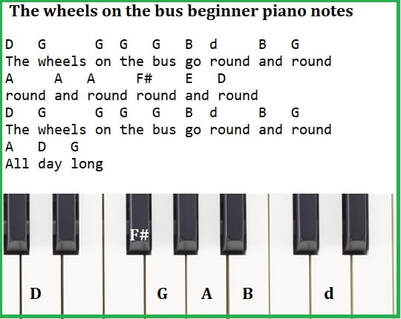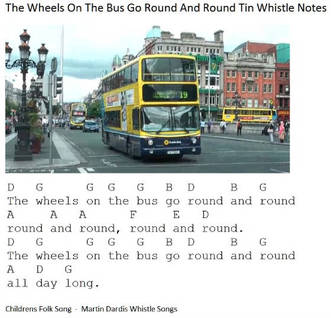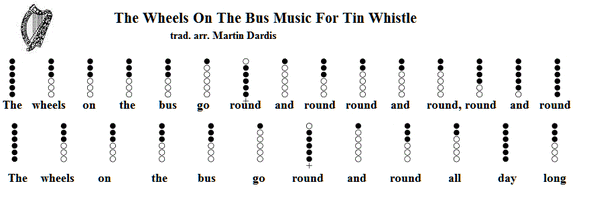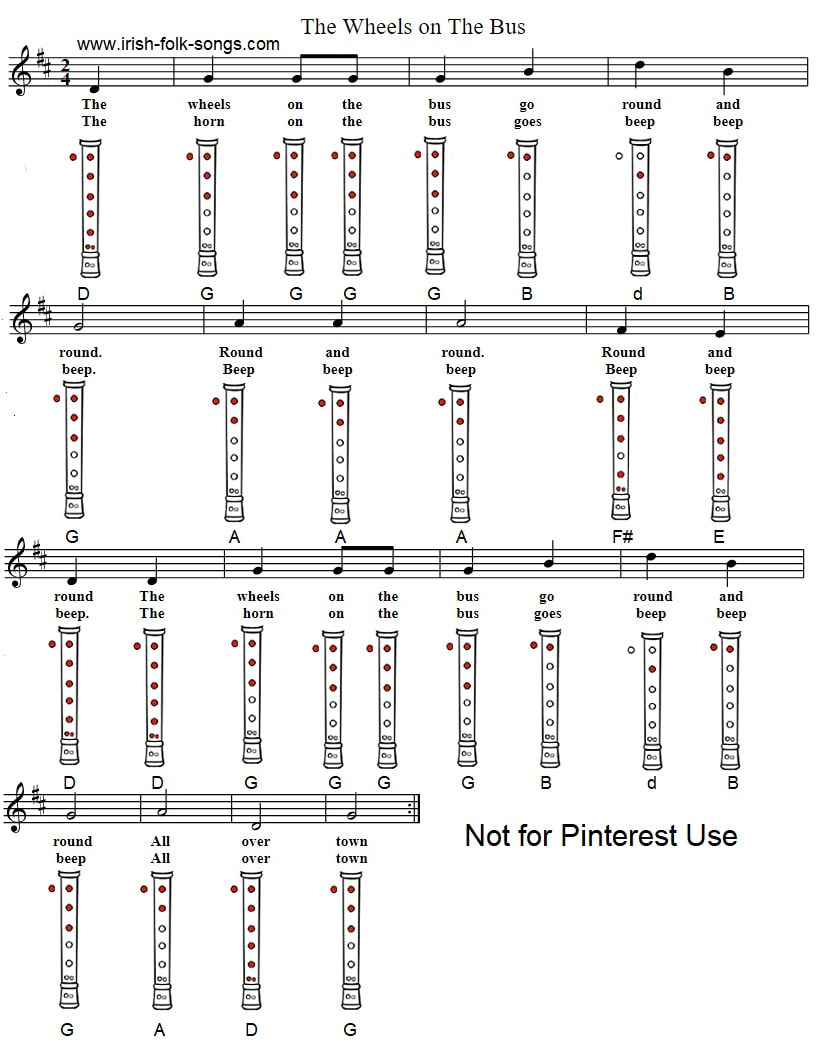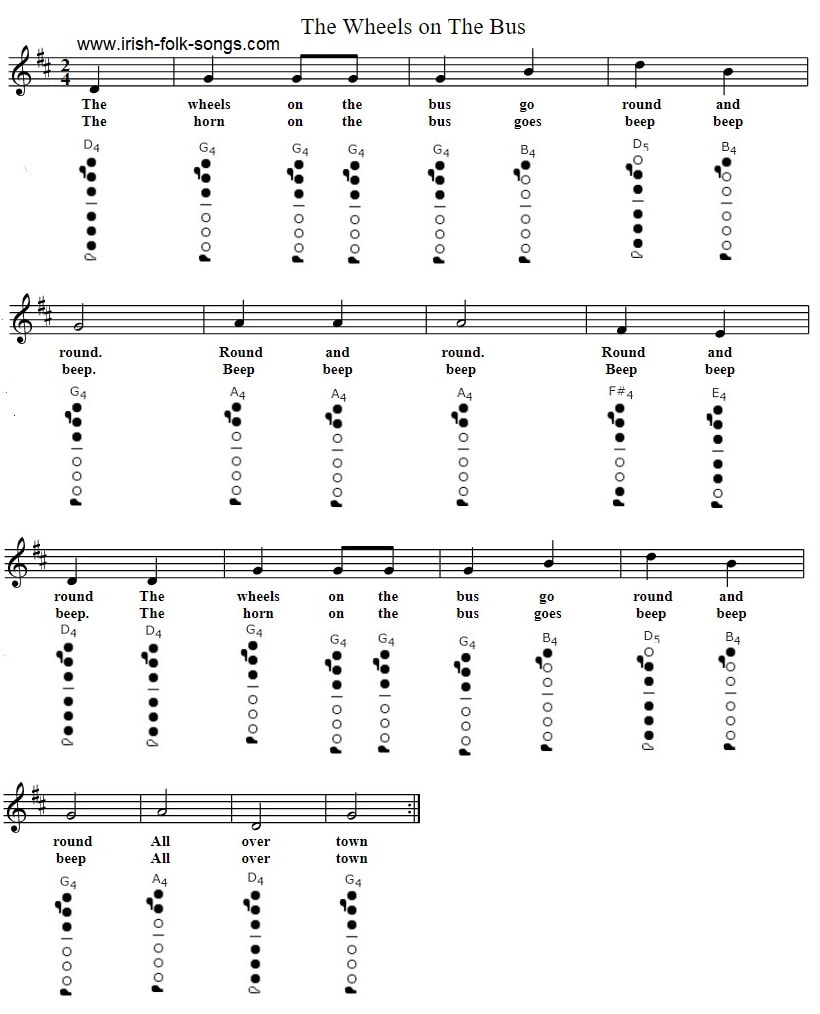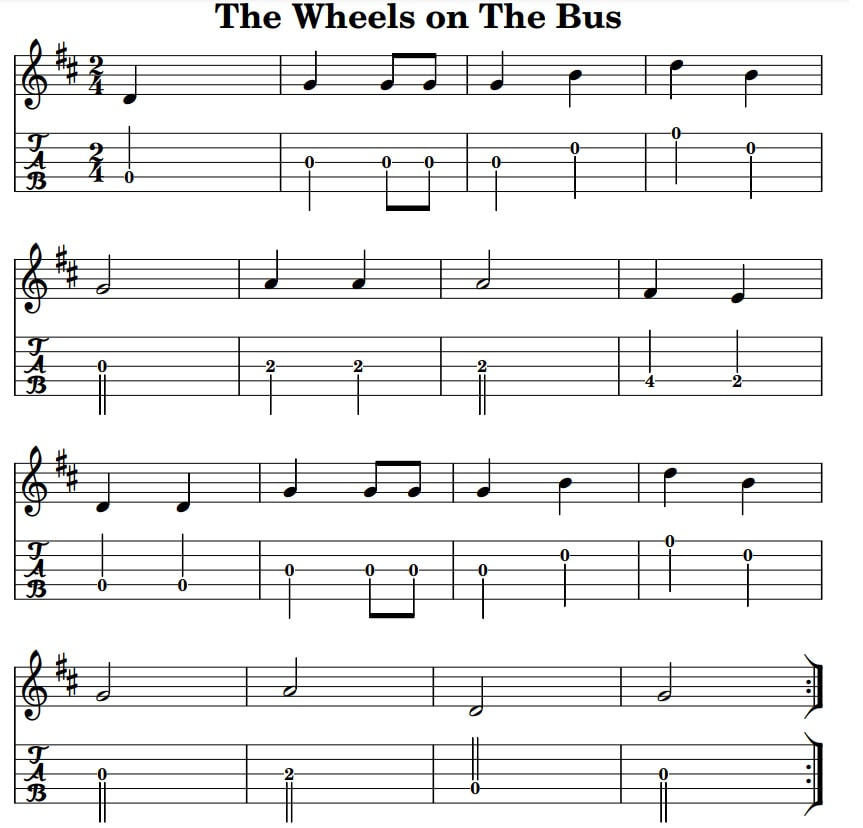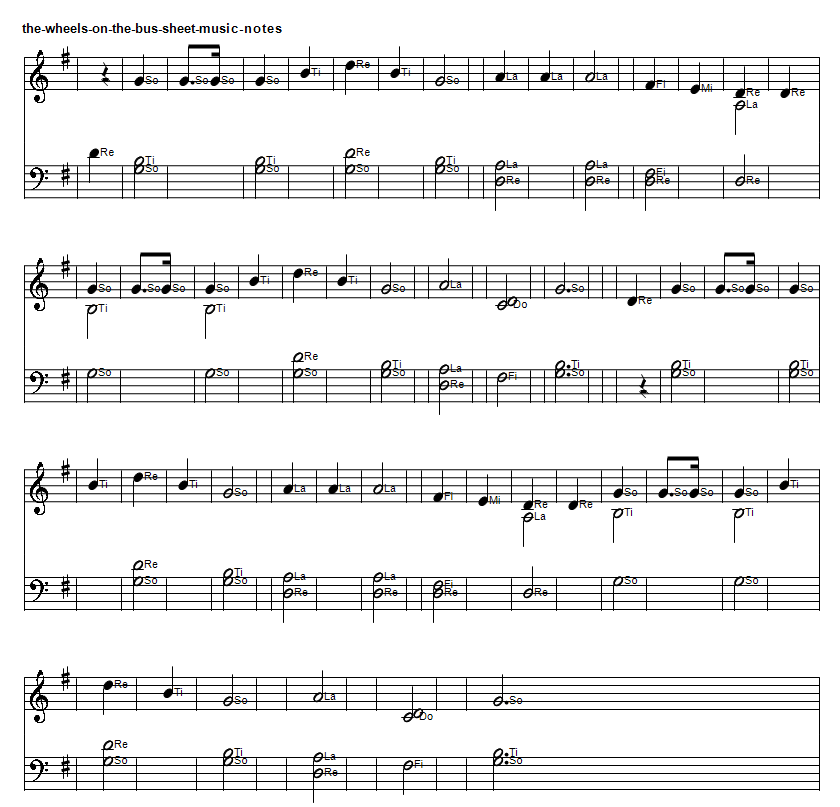The Wheels On The Bus Go 'Round And 'Round tin whistle notes
The wheels on the bus flute notes finger chart plus the recorder sheet music which also shows the fingering position and the basic letter notes for beginners. The image of the bus is from O'Connoll Bridge in Dublin Ireland. [Kids Whistle Songs] The first D' note at the start of the song is a low one and the second is a high D. This kids song is included within my tin whistle book which has a special section for kids songs. Piano sheet music notes for the wheels on the bus in the key of G Major with the solfege notes now added plus the easy beginner piano / melodica letter notes for beginners. The 5 string banjo tab is in D Major.
its impact on childhood development
Introduction
The Wheels On The Bus is a popular nursery rhyme that is often one of the first songs children learn. It has been a staple in early childhood education for decades, and its catchy tune and simple lyrics have made it a favorite among young children. However, the impact of this song on childhood development is often overlooked. In this thesis, we will explore the various aspects of The Wheels On The Bus, such as its origins, its role in early childhood education, and its impact on cognitive, social, and emotional development.
Origins of The Wheels On The Bus
The Wheels On The Bus has a long and interesting history, with its origins dating back to the early 20th century. The first known version of the song was published in 1939 in the book 'American Childhood' by Dorothy Berliner Commins. It was originally titled 'Here We Go Round the Mulberry Bush,' but the lyrics were modified to include a bus instead of a bush. The song has since been adapted and changed by different cultures and has become a part of the global nursery rhyme canon.
Role in Early Childhood Education
The Wheels On The Bus is a popular choice for early childhood educators, and for good reason. Its catchy tune and repetitive lyrics make it easy for young children to learn and sing along to. The song also incorporates actions and movements, such as the wheels going round and round, the wipers going swish, and the horn going beep, which not only make the song more engaging but also help children develop their motor skills.
Moreover, The Wheels On The Bus is often used as a teaching tool to introduce young children to the concept of transportation. By using a familiar and fun song, children can easily grasp the different parts of a bus and their functions. This helps them develop a basic understanding of the world around them and encourages curiosity and exploration.
Impact on Cognitive Development
The Wheels On The Bus has a significant impact on cognitive development in young children. Learning and singing the song helps children develop their memory and recall skills as they have to remember the lyrics and actions. This is especially beneficial for children with learning disabilities, as the repetitive nature of the song can aid in their learning process.
Furthermore, the song also introduces children to basic counting and sequencing skills. The lyrics of the song follow a specific order, and children have to count the number of times the wheels go round, the wipers go swish, and the horn goes beep. This helps develop their understanding of numbers and patterns, which are important foundations for mathematical concepts.
Impact on Social Development
The Wheels On The Bus also plays a crucial role in social development in young children. The song is often sung in groups, whether in a classroom setting or during playtime with peers. This encourages children to interact and engage with others, promoting social skills such as taking turns, sharing, and cooperating. Additionally, the song also introduces children to the concept of roles and responsibilities, as they can take turns being the driver, conductor, or passenger on the bus.
Moreover, The Wheels On The Bus also helps children develop their language and communication skills. By singing along with others, children learn new words and expand their vocabulary. They also learn how to communicate their thoughts and ideas to others, whether through singing or through actions.
Impact on Emotional Development
The Wheels On The Bus also has a positive impact on emotional development in young children. The song is often associated with happy and joyful feelings, and the repetitive and predictable nature of the song can be soothing for children. Singing and engaging in the actions of the song can also be a form of self-expression for children, allowing them to release their emotions in a safe and fun way.
Moreover, The Wheels On The Bus also helps children develop their sense of self and identity. By participating in a group activity, children learn to express themselves and their individuality, while still being a part of a collective group. This promotes a sense of belonging and self-esteem in young children.
Conclusion
In conclusion, The Wheels On The Bus is much more than just a catchy children's song. Its origins and evolution over time have made it a global nursery rhyme, and its role in early childhood education is undeniable. The song's impact on cognitive, social, and emotional development in young children cannot be overlooked. It not only helps children learn and develop fundamental skills, but it also promotes a sense of joy and community. The Wheels On The Bus will continue to be a beloved song for generations to come, with its lasting impact on childhood development.
Introduction
The Wheels On The Bus is a popular nursery rhyme that is often one of the first songs children learn. It has been a staple in early childhood education for decades, and its catchy tune and simple lyrics have made it a favorite among young children. However, the impact of this song on childhood development is often overlooked. In this thesis, we will explore the various aspects of The Wheels On The Bus, such as its origins, its role in early childhood education, and its impact on cognitive, social, and emotional development.
Origins of The Wheels On The Bus
The Wheels On The Bus has a long and interesting history, with its origins dating back to the early 20th century. The first known version of the song was published in 1939 in the book 'American Childhood' by Dorothy Berliner Commins. It was originally titled 'Here We Go Round the Mulberry Bush,' but the lyrics were modified to include a bus instead of a bush. The song has since been adapted and changed by different cultures and has become a part of the global nursery rhyme canon.
Role in Early Childhood Education
The Wheels On The Bus is a popular choice for early childhood educators, and for good reason. Its catchy tune and repetitive lyrics make it easy for young children to learn and sing along to. The song also incorporates actions and movements, such as the wheels going round and round, the wipers going swish, and the horn going beep, which not only make the song more engaging but also help children develop their motor skills.
Moreover, The Wheels On The Bus is often used as a teaching tool to introduce young children to the concept of transportation. By using a familiar and fun song, children can easily grasp the different parts of a bus and their functions. This helps them develop a basic understanding of the world around them and encourages curiosity and exploration.
Impact on Cognitive Development
The Wheels On The Bus has a significant impact on cognitive development in young children. Learning and singing the song helps children develop their memory and recall skills as they have to remember the lyrics and actions. This is especially beneficial for children with learning disabilities, as the repetitive nature of the song can aid in their learning process.
Furthermore, the song also introduces children to basic counting and sequencing skills. The lyrics of the song follow a specific order, and children have to count the number of times the wheels go round, the wipers go swish, and the horn goes beep. This helps develop their understanding of numbers and patterns, which are important foundations for mathematical concepts.
Impact on Social Development
The Wheels On The Bus also plays a crucial role in social development in young children. The song is often sung in groups, whether in a classroom setting or during playtime with peers. This encourages children to interact and engage with others, promoting social skills such as taking turns, sharing, and cooperating. Additionally, the song also introduces children to the concept of roles and responsibilities, as they can take turns being the driver, conductor, or passenger on the bus.
Moreover, The Wheels On The Bus also helps children develop their language and communication skills. By singing along with others, children learn new words and expand their vocabulary. They also learn how to communicate their thoughts and ideas to others, whether through singing or through actions.
Impact on Emotional Development
The Wheels On The Bus also has a positive impact on emotional development in young children. The song is often associated with happy and joyful feelings, and the repetitive and predictable nature of the song can be soothing for children. Singing and engaging in the actions of the song can also be a form of self-expression for children, allowing them to release their emotions in a safe and fun way.
Moreover, The Wheels On The Bus also helps children develop their sense of self and identity. By participating in a group activity, children learn to express themselves and their individuality, while still being a part of a collective group. This promotes a sense of belonging and self-esteem in young children.
Conclusion
In conclusion, The Wheels On The Bus is much more than just a catchy children's song. Its origins and evolution over time have made it a global nursery rhyme, and its role in early childhood education is undeniable. The song's impact on cognitive, social, and emotional development in young children cannot be overlooked. It not only helps children learn and develop fundamental skills, but it also promotes a sense of joy and community. The Wheels On The Bus will continue to be a beloved song for generations to come, with its lasting impact on childhood development.
Below is the list of sheet music and tin whistle songs that are in my ebooks. This is the largest collection of tin whistle songs ever put together.[over 800 songs ] Including folk, pop and trad tunes plus German And French songs along with Christmas Carols.
All of the sheet music tabs have been made as easy to play as was possible.
The price of the ebooks is €7.50
All of the sheet music tabs have been made as easy to play as was possible.
The price of the ebooks is €7.50
Piano sheet music notes for the wheels on the bus in solfege [ do re mi ]
The wheels on the bus go 'round and 'round song lyrics [ 2 ]
Verse 1:
The wheels on the bus go 'round and 'round
As we travel through the town
Passing by buildings and trees
With the wind blowing through our hair
Chorus:
Round and round, we go
On the bus, to and fro
Seeing the world, passing by
With the wheels on the bus, we'll fly
Verse 2:
The wheels on the bus go 'round and 'round
As we sing our favorite songs
The laughter and joy, it surrounds
As we journey along
Chorus:
Round and round, we go
On the bus, to and fro
Seeing the world, passing by
With the wheels on the bus, we'll fly
Bridge:
Through the rain and through the sun
The wheels keep spinning, never done
Taking us to new places
With smiles on our faces
Chorus:
Round and round, we go
On the bus, to and fro
Seeing the world, passing by
With the wheels on the bus, we'll fly
Outro:
So let's keep riding, 'round and 'round
On this bus, we'll never frown
With the wheels on the bus, we'll go
On our journey, to and fro.
Verse 1:
The wheels on the bus go 'round and 'round
As we travel through the town
Passing by buildings and trees
With the wind blowing through our hair
Chorus:
Round and round, we go
On the bus, to and fro
Seeing the world, passing by
With the wheels on the bus, we'll fly
Verse 2:
The wheels on the bus go 'round and 'round
As we sing our favorite songs
The laughter and joy, it surrounds
As we journey along
Chorus:
Round and round, we go
On the bus, to and fro
Seeing the world, passing by
With the wheels on the bus, we'll fly
Bridge:
Through the rain and through the sun
The wheels keep spinning, never done
Taking us to new places
With smiles on our faces
Chorus:
Round and round, we go
On the bus, to and fro
Seeing the world, passing by
With the wheels on the bus, we'll fly
Outro:
So let's keep riding, 'round and 'round
On this bus, we'll never frown
With the wheels on the bus, we'll go
On our journey, to and fro.
